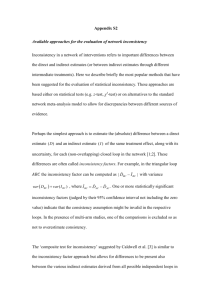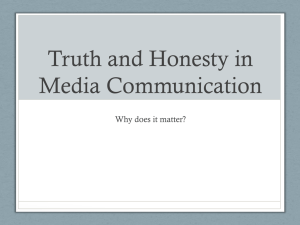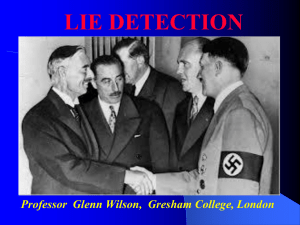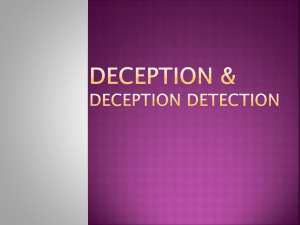Fisher - iIIRG
advertisement
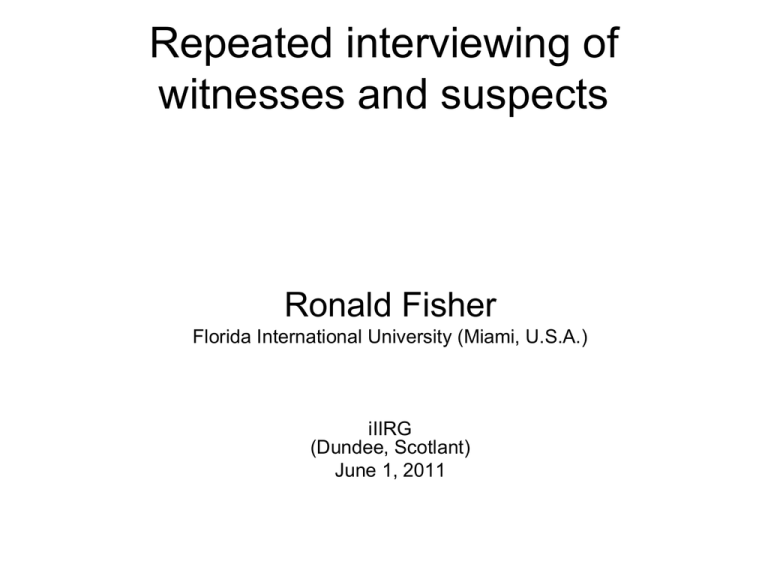
Repeated interviewing of witnesses and suspects Ronald Fisher Florida International University (Miami, U.S.A.) iIIRG (Dundee, Scotlant) June 1, 2011 Accuracy rate per response category (Gilbert & Fisher) Time 1 Consistent Forgotten Reminiscent Contradictory .95 .93 -.62 Time 2 .95 -.87 .35 Legal Challenges: Judge’s instructions Florida Standard Jury Instructions in Criminal Cases, 1987,# 204, sub-para 8:… “Did the witness at some other time make a statement that is inconsistent with the testimony he gave in court?” Legal Challenges: Recommended cross-examination Bailey & Rothblatt (1971, p. 177): “Capitalize on these conflicts. This is the most effective way of discrediting [the witness’ s] entire testimony.” Glissan (1991, p.108): “A true inconsistency can effectively destroy a witness, and sometimes a whole case…If you find a true inconsistency, or if you can manufacture one, then use the deposition of previous evidence to sheet it home.” Poets know best • Ralph Waldo Emerson: • “Foolish consistency is the hobgoblin of small minds.” Multiple interviewing • Most witnesses are interviewed repeatedly • Relatively little research, however, on multiple interviewing What do we gain from multiple interviewing? • Opportunity to collect new information • Opportunity to compare responses across interviews Collect New Information • How often is new information generated on a second interview (not collected on the first): reminiscence? • How accurate is reminiscent information? Frequency of Reminiscence • Gilbert & Fisher (2006) • Procedure: – See video, T1 (immed), T2 (2 days) – Free Recall or Guided Recall • Results: 189/192 show reminiscence (others: Yuille & Turtle; Gabbert, et al) • Mean number of reminiscences: 8.19 • Reminiscence is common experience Accuracy of Reminiscence • Accuracy rate of reminiscence .87 • Comparable results reported by others, e.g., LaRooy et al. • Conclusion – repeated testing is very likely to generate new, accurate information – as long as questions are open-ended Goal • To test the assumption that inconsistency is an indicator of a weak memory or deception. • How valid is this assumption? Overview • Separate for inferences about memory and deception. • To show that people do rely on inconsistency to infer about memory accuracy and deception. • Q? In fact, is inconsistency a good predictor of memory accuracy and deception? • Sometimes. Beliefs about Inconsistency • Sign of a weak memory • Sign of deception People are swayed by these inconsistencies • Surveys: – College Students (Brewer, Potter, Fisher, Bond, & Luszcz, 1999) – Police, prosecutors, & defenders (Potter & Brewer, 1999) • Experimental jury simulations – Berman, Narby, & Cutler (1995) – Brewer & Hupfeld (2004) Legal Challenges: Recommended cross-examination Bailey & Rothblatt (1971, p. 177): “Capitalize on these conflicts. This is the most effective way of discrediting [the witness’ s] entire testimony.” Glissan (1991, p.108): “A true inconsistency can effectively destroy a witness, and sometimes a whole case…If you find a true inconsistency, or if you can manufacture one, then use the deposition of previous evidence to sheet it home.” Legal Challenges: Judge’s instructions Florida Standard Jury Instructions in Criminal Cases, 1987,# 204, sub-para 8:… “Did the witness at some other time make a statement that is inconsistent with the testimony he gave in court?” Attorneys’ vs. Researchers’ Goals • Attorneys : to convince jurors or judges that their side of the argument is correct. • Scientists: to find out the truth and to explain it. Part I: Inconsistency as a indicator of Memory Accuracy Scientific Research on Inconsistency • Prior to 1970: very few studies – Difficult to conduct (resource demanding) – Memory theories about single recollections – Exceptions (Erdelyi; Payne) Recent Studies • Naturalistic Studies – Flashbulb memories (e.g., Pezdek) – Holocaust survivors (Wagenaar & Groenweg) – Epidemiological/Health (Fisher, et al) • General Findings: some inconsistency • Limitations: cannot measure accuracy • Need laboratory studies to measure accuracy “Blended” experiments • 19 Experiments Fisher & Cutler (1996), Brewer et al (1999), Patterson & Fisher (2005); Gilbert & Fisher (2006); Mitchell, Haw, & Fisher (2003); Fisher & Hazel (in preparation) • Method: – Event: videotape or live event – Two tests (T1 & T2): • T1 is immediate or after a few hours • T2 is a few days or one or two weeks later – Test questions: open-ended or closed (cued recall) – T1/T2 cue similarity: same or different, e.g., temporal/temporal (same) or temporal/spatial (diff.) Witness Recall at Time 1 & Time 2 T1: ….tall, hat, jacket, scar, red hair T2:…..tall, hat, jacket, ……, bald,…. belt Consistent: T1 + T2 Forgetting: T1 only **Contradiction: T1 + T2 different **Reminiscence: T2 only Measuring Accuracy • Accuracy rate = # correct___ total # responses • Calculate separately for each of the 4 response categories: – Consistent – Reminiscent – Forgotten – Contradictory Measuring Consistency • Consistenct rate = # consistent__ total # responses • Calculate separately for each of the 4 response categories Three Corollaries of Belief (Inconsistency = Inaccurate) 1. Inconsistent statements are inaccurate 2. Witness who make more inconsistent statements are less accurate 3. Consistency and accuracy reflect one, common, underlying process Corollary # 1: Inconsistent statements are inaccurate • To examine accuracy of 4 kinds of statement: • Consistent • Forgotten • Reminiscent • Contradictory Accuracy rate per response category (Gilbert & Fisher) Time 1 Consistent Forgotten Reminiscent Contradictory .95 .93 -.62 Time 2 .95 -.87 .35 Conclusion # 1 • Inconsistent statements are less accurate, but we should distinguish between different forms of inconsistency • Reminiscent statements are still generally (.87) • Only contradictory statements are much less accurate (.62 @ T2; and .35 @ T2) Corollary # 2: Inconsistent witnesses are inaccurate • To examine the correlation between overall consistency and overall accuracy (across witnesses) Correlations between consistency and overall accuracy (Gilbert & Fisher) • Proportion contradictions: -.17 (non-significant) • Proportion reminiscence: (non-significant) .03 • Similar pattern (small, non-significant correlations) in other experiments Conclusion # 2 • Inconsistent witnesses are only minimally less accurate than consistent witnesses. Puzzling Finding • Contradictory statements are much less accurate than consistent statements, but… • inconsistent witnesses are only minimally less accurate than (or the same as) inconsistent witnesses Solution to puzzle: Items are processed independently • Accuracy of recalling one set of items (e.g., car) does not predict accuracy of recalling another set of items (e.g., perpetrator) Support for Independence explanation • Examine categories of information (e.g., car, perpetrator, setting). • Examine inter-category correlations. • Across 8 experiments, mean intercategory correlation = .11 (Brewer, et al.1999; Mitchell, Haw & Fisher, 2003) Implications of Independence for courtroom and investigation • Cannot challenge an entire witness’s testimony, because he/she recalls some items incorrectly. • Can challenge only those individual statements that we believe are incorrect (e.g. contradiction). Corollary # 3 • Consistency and accuracy reflect one, common underlying process Test Logic • Do experimental manipulations have the same or different effects on consistency and accuracy? (Experimental dissociation) • Same effects one underlying process Different effects multiple underlying processes Experimental Results • Some manipulations have the same effects on consistency and accuracy, e.g., question format (open-ended vs. closed) • Some manipulations have different effects on consistency and accuracy, e.g. delay: decreases accuracy but increases consistency Conclusions • Some common elements -- but almost all measures have some common elements. • Some processes influence one measure but not the other. • Ultimate: Cannot reflexively interpret inconsistency to indicate accuracy A Framework for Understanding Inconsistency • Something must change from T1 to T2, but what? Candidates for Change • Mental representation: knowledge base • Retrieval processes: questions, interviewers • Metacognition: monitoring one’s knowledge Part 2: Inconsistency as an indicator of deception Two Approaches 1. What do people believe? 2. Is this belief valid? What is the truth? Beliefs about Inconsistency as an indicator of deception: Real-world assessments • Training agencies • Interrogation manuals • Surveys of police & judges Beliefs about Inconsistency as an indicator of deception: Laboratory Studies • Self-assessments • Experimental manipulations Consistency Heuristic • Everyone believes that inconsistent reports are grounds for doubting one’s veracity. How valid is the “consistency heuristic”? • Scientific, controlled studies • Advantage of scientific, controlled experiments: We know who is, in fact, lying and who is telling the truth. Scientific Research on Consistency and Deception • Relatively little research • Research is resource-demanding • Multiple testing • Compare answers across tests • Two laboratories: Granhag/Stromwall Vrij/Fisher Typical Laboratory Study • Truth-tellers engage in an activity; liars do not do the activity, but are asked to convince an interviewer that they did. • Interviewed/Tested twice (Int-1, Int-2) – Interval varies from hours to days – Interviewed individually or in pairs • Compare their answers (consistency) – Within respondents (Int-1 and Int-2) – Across respondents (Resp # 1 and Resp # 2) Two Patterns of Results • Sometimes liars are as inconsistent (or even less) as truth-tellers (Granhag/Stromwall) • Sometimes liars are more inconsistent than truth-tellers (Vrij/Fisher) Differences between Granhag/Stromwall & Vrij/Fisher • Preparation for Interview: G/S vs. V/F • Questions asked at interview (anticipated or not): G/S vs. V/F • Similarity of questions at Int-1 and Int-2: G/S vs. V/F Preparation for Interview • Liars rehearse their story; truth-tellers do not • Liars are prepared to give a narrative Liars Prepare: Evidence • Observe liars and truth-tellers before being interviewed – Secondary task—catching liars with cartoons: Cahill + Fisher – Videotape preparing for interview shown to observers (lie detectors): Cahill + Fisher Prepared for Anticipated Questions • Liars are prepared to answer typical questions: “What happened?” • Liars can give same answers on two different interviews, if they are prepared (they anticipate the questions) • G/S: anticipated Q: “What happened?” F/V: unanticipated Qs “Location of waiter?” Strategic Differences • Liars (be convincing, i.e. consistent) vs. Truth-tellers (be informative) • Liars: Repeat vs. Reconstruct (Granhag/Stromwall) • Implications for Question Similarity between Int-1 and Int-2 Similarity of Questions at Int-1 and Int-2 • Similar questions facilitate repeating earlier answer (consistent responding). • Different questions yield more inconsistency, but mainly for liars: Verbal and pictorial (sketch) reports (Vrij et al; Leins et al) Leveraging Liars’ strategies (consistent) to detect deception • Different strategies – Liars: to be consistent – Truth-tellers: to provide information • Different strategies yield different behaviors in repeated testing: To provide new information (truth-tellers) or not (liars)? (Pludwinski) – Converging results: individuals and pairs Summary of Deception Research • Liars are consistent only if they can 1. prepare for and anticipate the interviewer’s questions 2. remember their earlier (Int-1) answers Interviewing Strategy to “produce” inconsistency in liars • Think about how liars might prepare for an interview, and ask unanticipated questions • Ask different questions across interviews Overview of Inconsistency Research • No simple rule to infer whether inconsistent respondents – have generally poor memories – are deceptive or truthful • Behavioral patterns are complex Approaches to complex patterns 1. Abandon reliance on inconsistency. Limited utility a. sometimes inconsistency is diagnostic b. we must rely on some cues; what would substitute for inconsistency? Preferable approach 1. Better to understand the nature of inconsistency, when it is and when it is not an indicator of poor memory and deception. a. Here, hinted at some cognitive and social approaches b. Researchers and practitioners to develop these and other ideas more thoroughly. Questions & Comments • Thank you!
